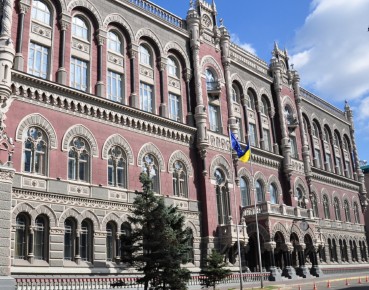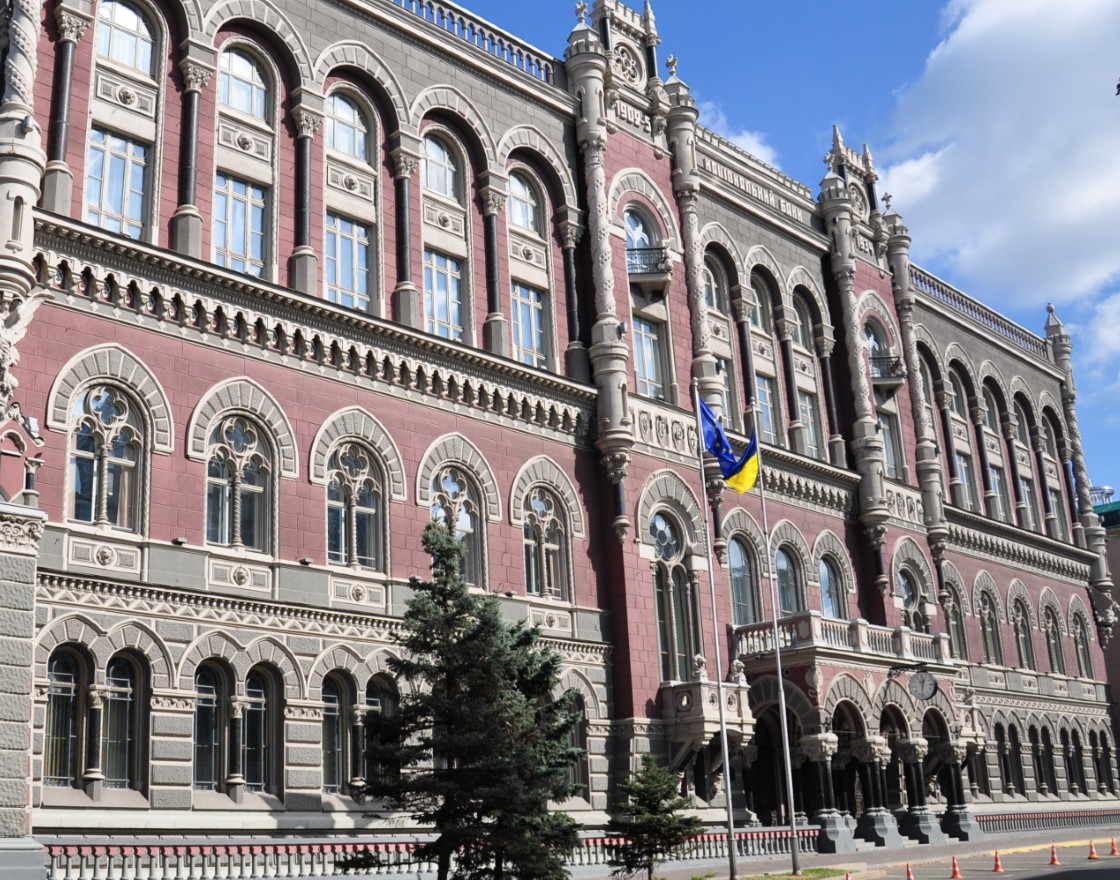
NBU headquarters, Kiev, Ukraine (Musia-97, CC BY-SA)
Last year, the foreign currency reserves of the Ukrainian central bank (NBU) increased by USD4.5bn, or as much as 22 per cent, from USD20.8bn in January 2019 to USD25.3bn in December. They reached a seven-year record — the highest level of reserves recorded since 2012. In one year, NBU purchased USD7.9bn on the market — the highest amount in the last 14 years.
The highest monthly increase was recorded in December 2019 and was supported by the lower debt-service payments than in the previous months and the increased supply of foreign currency on the interbank market. The central bank purchased as much as USD2.9bn and spent only USD220m on servicing its foreign debt. USD514m came in from the purchasers of bonds, and the central bank obtained almost USD144m thanks to the strengthening of the UAH exchange rate and the revaluation of financial instruments denominated in the national currency.
The agricultural sector supplied foreign currency
Throughout 2019, the supply of foreign currency on the interbank market significantly exceeded the demand. Describing the reasons for the significant increase in the level of its reserves, the NBU stated that their high level was generated by Ukrainian exporters, above all by the agricultural sector, which increased sales. International investors, who purchased USD4.3bn worth of the UAH-denominated Treasury bonds, also contributed to the increase. In addition, state-owned and private companies attracted external financing.
At the same time, importers’ demand for foreign currency was moderate due to the fall in global fuel prices. The amount of dividends repatriated by businesses was also lower.
The NBU calculated that the level of foreign reserves could cover the needs of Ukrainian imports for three months and was sufficient to cover the current operations of the central bank and the government.
There’s a lot and there’ll be more?
The Governor of the NBU, Jakiv Smolii, informed the public that by the end of 2020 Ukraine’s foreign currency reserves would reach USD29bn, thanks to funds from the IMF and the sale of the UAH-denominated Treasury bonds to foreign investors. The central bank estimated that by the end of 2022 they could even rise to USD32bn. The condition for this trend is the sustained interest in Ukrainian bonds among foreign investors and continued cooperation with the IMF.
The NBU states that the balance of payments surplus, combined with the inflow of funds from the IMF, will allow it to accumulate reserves at the level of the forecast, regardless of the level of debt service payments. Thanks to this, it will be possible to meet 100 per cent of the IMF’s reserve adequacy criteria.
The Ukrainian central bank also points to additional potential sources of increasing its reserves. This is mainly money from the state-owned company Naftogaz of Ukraine — almost USD3bn, which it received from Russia’s Gazprom as a result of last year’s decision of the arbitration tribunal in Stockholm.
The NBU has bought USD500m from the company. There is still USD2.4bn “up for grabs” on its accounts. “We see no need for Naftogaz to hold this foreign currency for internal payments. The company has additional foreign currency income from the transit of Russian gas, which is why we expect this money will enter the market. If companies and commercial banks do not purchase it, then the central bank will in order to increase its reserves,” Smolii said.
Another source are loans from the IMF, the World Bank and the European Union. It is possible that they could be supplemented by the government entering foreign capital markets.
The relatively high level of foreign reserves makes the Ukrainian economy more stable and independent. At the same time, its reputation among investors is not the best. This means that the role of the IMF program is more political than economic. According to the Ministry of Economy, “its existence convinces foreign and domestic investors about the responsible economic policy of the government.”
The Treasury received a further USD1.7bn from the beginning of 2020 till March. The level of reserves was already approx. USD27bn. As the NBU explains, this was the result of, on the one hand, the government’s Eurobond issue, and on the other hand, the central bank’s reserve management operations and operations on the currency market.
The government issued bonds worth EUR1.25bn and spent USD656m on servicing existing debt. The NBU purchased USD348m on the interbank market. The revaluation of the UAH-denominated financial instruments due to the appreciation of the national currency gave USD178m.
Good or bad structure?
At the beginning of the year the structure of the reserves was as follows: USD21.31bn (84.2 per cent of total reserves) in securities, USD2.77bn in cash and on bank accounts, and USD1.22bn in gold. Securities with an AAA rating were worth USD13.3bn, AA rating — USD2.17bn, and A rating — USD5.75bn. Broken down by reserve currencies, the NBU held USD19.4bn in the USD, USD2.68bn in the EUR, USD0.58bn in the GBP, USD0.79bn in the CNY, and USD0.59bn in the JPY.
The vast majority of funds borrowed from the IMF have not been spent, but are supplementing the reserves. “This is a signal of stability for investors. In their opinion, the IMF’s cooperation with a given country means that it has a predictable government conducting a policy that does not allow a budget or trade deficit,” explained the coordinator of the NBU’s expert platform, Andrei Blinov.
However, not everyone believes that this is a good solution. Increasing the central bank’s reserves with the help of loans from international financial institutions and investing in securities is a controversial approach. The vice-chairman of the parliamentary commission on finance, Aleksandr Dubynski, draws attention to the unfavorable structure of the Ukrainian reserves. While the majority of central banks try to invest a significant portion of their reserves in gold, the Ukrainian central bank invests in foreign securities — as much as 85 per cent are bonds issued by the USA.
In his opinion, this calls into question the Ukrainian government’s declared need for foreign loans. “There’s a long story about how much we need loans, because we have to rebuild our economy and attract investment. We take loans in foreign currency and we don’t invest them in our economy, but in the foreign debt of the USA, thereby financing their budget deficit. So all our increases in gas charges, the fuss about raising the retirement age, the sale of land, the sell-off of state enterprises — without these measures we will not get loans. All this is so that we can borrow money at 7 to 13 per cent annually, but with the debt that we have incurred we purchase US bonds with an interest rate of 0.5 per cent annually. In this way we are giving away our GDP,” he commented.
Coronavirus weakens the reserves
The coronavirus pandemic places a question mark over the NBU’s plans to increase the level of its reserves. Instead of growing at the beginning of March, they have decreased from USD27bn to just over USD24bn as a result of the central bank’s struggle to halt the dramatic devaluation of the UAH. The money has been spent, but the intervention was ineffective and the UAH has devalued by over 10 per cent.
Experts drew attention to it a long time ago, since it prevented the central bank from reacting quickly. In order to satisfy Ukrainians’ demand for the USD, which is scarce in the Treasury, the NBU first had to sell its securities on foreign markets and then transport the cash by plane.
This was hampered by the restrictions on air transport due to the pandemic, and took several days. It resulted in heightened concerns on the already highly unstable cash market.

